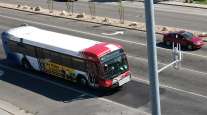Senior Reporter
NHTSA: Alcohol Use Down, Marijuana Up
WASHINGTON — Alcohol use by motorists on U.S. highways has declined significantly in recent years. However, the use of marijuana among the driving public is on the rise, according to research by the National Highway Traffic Safety Administration.
“Big picture, we’re doing great in alcohol. We’re getting alcohol separated from driving,” NHTSA research psychologist Amy Berning said during a Jan. 13 session at the annual meeting of the Transportation Research Board.
“What we’re now able to see is drug use is increasing, especially marijuana use,” Berning said.
However, the story is different for roadside testing of potentially impairing drugs, including cannabinoids, stimulants, sedatives and antidepressants.
Berning said NHTSA researchers began conducting roadside surveys of about 70 different over-the-counter, prescription and illegal potentially impairing drugs in 2007.
The research involved asking motorists to pull off the road at one of 60 sites nationwide where the agency handed out questionnaires and sought volunteers to anonymously blow into a Breathalyzer, allow oral fluid swabs or blood tests for prevalence of drugs.
Berning said the drug with the largest increase from 2007 and 2013-2014 surveys was weekend nighttime use of marijuana.
In 2007, 8.6% of weekend nighttime drivers tested positive for marijuana, but 12.6% did in the most recent survey. Agency researchers are building on a
40-year knowledge base of alcohol impairment by motorists through testing and research, but illegal, prescription and over-the-counter drug research is relatively new, Berning said.
The results of recent testing for alcohol has been encouraging, she said, adding that the percentage of weekend nighttime drivers in recent agency roadside surveys showed the presence of alcohol has declined to 5.2% from 22.3% in 1973. Drivers with high levels of alcohol — 0.08 and above — declined to 1.5% in the latest agency survey from 7.5% in 1973, Berning said.
Although many questions have yet to be answered, agency researchers have a theory that might explain the reason drivers increasingly are taking to the highways using marijuana. That theory is, at least in part, that “changes in state policy on marijuana use, including medical and recreational use, may have contributed to an increase in marijuana use by drivers,” the NHTSA report said.
“Whereas the impairment effects for various concentration levels of alcohol in the blood or breath are well-understood, there is little evidence available to link concentrations of other drugs to driver performance,” the 2015 study reported.
Drowsy driving is another trend that merits and is slated to receive future agency research, NHTSA researcher Stephen Higgins said at the session.
“In some ways now, drowsy driving is in the same position as drugs in the ’70s,” he said. “So many people are doing it, yet not admitting that it’s an actual serious problem.”
Higgins said surveys have shown about 4% of the driving population has admitted to dosing off at the wheel in the past 30 days.
That number climbs to 8% when the time period is six months and to 50% from 40% when an individual considers the total number of years he or she has been behind the wheel, he said.
“That really only accounts for people falling asleep,” Higgins said.
He called drowsy driving an “all-encompassing impairment” and something that you can’t turn off like distraction.
“You can put down the phone, but you can’t turn off the drowsiness,” he added.




